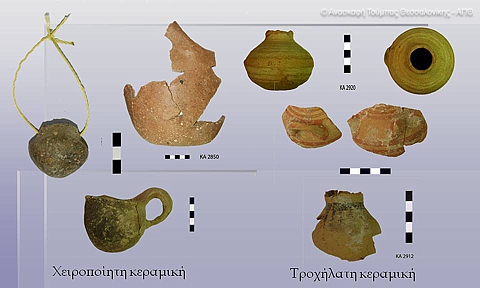Pottery
The Middle Bronze Age deposits include solely monochrome coarse burnished and striated handmade pottery. Tableware pottery, as a whole, is burnished, black, brown and red. It mainly includes hemispherical basins and bowls with horizontal handles and smaller kantharos- shaped drinking vases which are either s-shaped or carinated.
In spite of some general similarities, the known categories and shapes of the Mynian pottery, which is characteristic in both central and Southern Greece and even in Chalcidice in small amounts, do not appear at Toumba.
During the early LBA phases, tableware pottery is significantly enriched with new shapes and mostly new decorated pottery categories. On the contrary, the undecorated burnished pottery presents standardization elements, since it is limited to the brown burnished category and to a small number of shapes. In the decorated categories, at first a small number of incised, small dark burnished, closed spherical vases appear, and a little later so do the first few matt-painted vases (mostly open shapes, known in the site from earlier undecorated pottery). At this phase, the oldest Mycenaean sherd of the LH II style also appears.
The limitation in the variety of shapes and surface continues during the later LBA phases in the undecorated and burnished handmade tableware pottery. The basin with the wishbone handles is its most popular shape. This pottery category consistently prevails until the beginning of the EIA.
The decorated handmade pottery decreases in these phases. The few incised vases are richly decorated with white or red crusted ornamentation. Gradually, the matt-painted vases also decrease, first the open drinking vessels and later the amphorae and the jugs.
The beginning of the later phases of the LBA is marked and dated by few, mostly imported, decorated vases of LH ΙΙΙ Α2 and III B styles.
The quantity of the LH III C Mycenaean style decorated vases belonging to edifices from the end of the LBA is much greater. The successive reconstructions of the edifices οn the top of the settlement offer a well-stratified sequence of the phases of the transition to the EIA, as dated by Mycenaean vases of the subphases of the LH ΙΙΙ C period.
Some more recent edifice reconstructions are dated by the presence of Early Protogeometric style vases, which are decorated with concentric circles made by multiple brush. The decorated wheel-made pottery of this phase and of the immediately preceding ones was for the most part locally produced, as shown by the stylistic, chemical and petrographic analysis of a great number of samples.
The surface stratum of the top mainly includes pottery that dates back to the 6th until the 4th century B.C.
Pottery of the periods between the 10th and the 6th century B.C. has been found in non-stratified deposits in the trenches of the Toumba slope.


